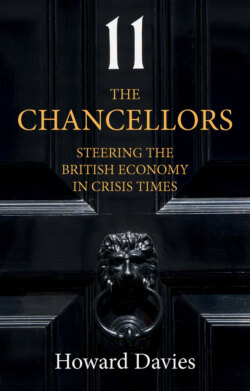Читать книгу The Chancellors - Howard Davies - Страница 9
2010–16: The austerity years
ОглавлениеThat was the difficult background against which the Coalition government was formed in May 2010. George Osborne, who had been Shadow Chancellor since David Cameron became leader of the Conservative Party in 2005, was the inevitable choice for 11 Downing Street. The complex negotiations over the leading positions in government led to the appointment of Liberal Democrat MP David Laws as Chief Secretary to the Treasury (CST), soon replaced by Danny Alexander, making him an unusually powerful holder of that post, as one of the ‘Quad’ of key decision-makers in the government.
The economy had, in fact, begun to recover in the first quarter of 2010, though that was barely perceptible to the electorate while unemployment continued to rise, as it did for another year or more. Although the recovery was steady, without a second recession, triggered in other parts of Europe by the Eurozone crisis, there was no post-recession boom as had typically been seen after earlier downturns. The economy returned to growth, but on a lower trajectory than before. The Institute for Fiscal Studies (IFS) estimated that in the summer of 2018 GDP was 11% higher than it had been at the pre-crisis peak in 2007–08, so the economy was 16% smaller and GDP per head was £6,000 lower than they would have been had growth remained on its pre-crisis trend.9
Surprisingly, employment growth remained strong, and there were 2.7 million more people in work in 2018 than a decade before. So average household incomes were higher than in 2008, and household income inequality had fallen a little. But the worst news was that productivity per hour grew by a mere 0.3% a year compared to a long-term trend of 2% a year. Output per hour worked was 18% below the average for the G7, and the current account deficit in 2015 was at a record high of 5.2%. The IFS summary stated:
The UK economy has broken record after record, and not generally in a good way: record low earnings growth, record public borrowing followed by record cuts in public spending. On the upside employment levels are remarkably high and, in spite of how it may feel, the gap between rich and poor has actually narrowed somewhat, but the gap between old and young has grown and grown.10
That may seem to be a definitively negative verdict on the Coalition government’s performance. But through an international lens the position looks rather different. The immediate recession hit to the UK economy was large by international standards, reflecting the high relative size of the financial sector. In 2011, growth in UK GDP remained below the average for the other advanced economies. But by the end of 2012 the UK was expanding a little more rapidly than the average, and that remained true until the middle of 2016, except for a brief period in 2015.11 That average was, however, reduced by the impact of the Eurozone crisis of 2010–12.
Economic opinion was divided on the extent to which Osborne could claim any credit for the recovery. Simon Wren-Lewis has argued that the government’s austerity programme unnecessarily cut 1% from the growth rate in 2011 and 2012, while Nicholas Crafts considered that the deficit reduction programme made little difference to the speed of the recovery.12
The underlying problem, however, which preoccupied economists and policymakers alike, was stagnant productivity. Productivity has flat-lined since 2010, a performance unprecedented since 1860.13 As Paul Krugman of Princeton observed: ‘Productivity isn’t everything, but in the long run it is almost everything. A country’s ability to improve its standard of living … depends almost entirely on its ability to raise its output per worker.’14 After 2010, productivity growth slowed almost everywhere in the developed world, but it fell more sharply in the UK than elsewhere in the G7, except Italy. In the last decade of the twentieth century German and British productivity growth rates, measured as the change in output per hour worked, were similar, at about 2.5% a year. In the second decade of the twenty-first century German productivity growth was around 1% a year. The UK rate had fallen to just below 0.4%.
Unpicking the causes of this differential is not straightforward, but two other measures are relevant. The UK has invested a lower share of GDP than Germany. Since 2007, UK investment as a share of GDP has consistently been the lowest in the G7. In the EU, only Greece invested less. UK fixed capital formation was a little over 16%, while German investment was over 20%. And the comparisons on R&D expenditure are even less favourable. The UK typically spends about 1.7% of GDP on R&D, compared to 2.8% in Germany.15
So the second of the three periods, from 2010 to 2016, shows a mixed picture: a slow start, a catch-up to roughly the average growth rate of comparator countries, but underlying weakness in investment and productivity, which suggested continuing sluggish growth, unless performance in those areas picked up.
